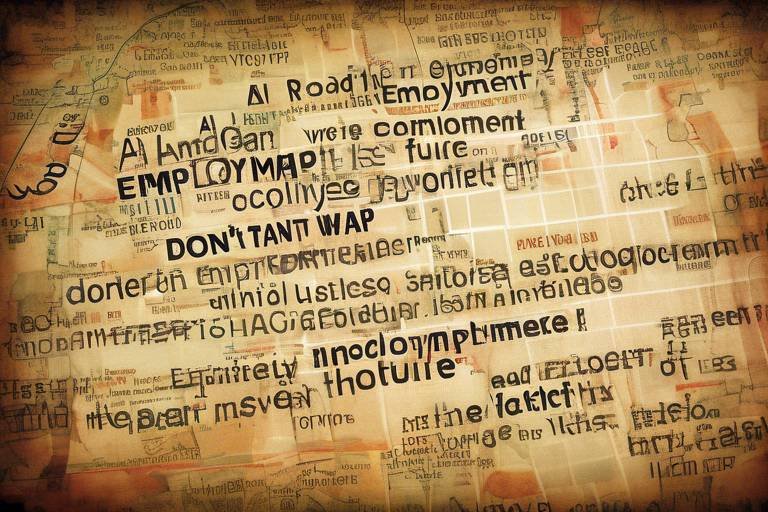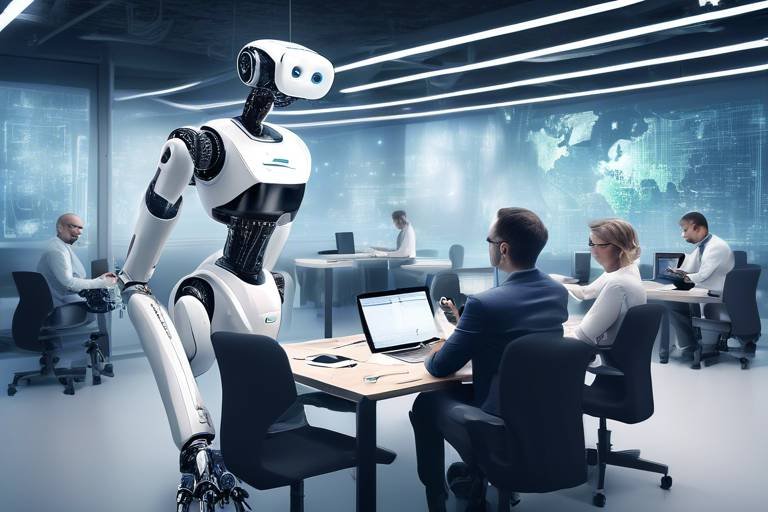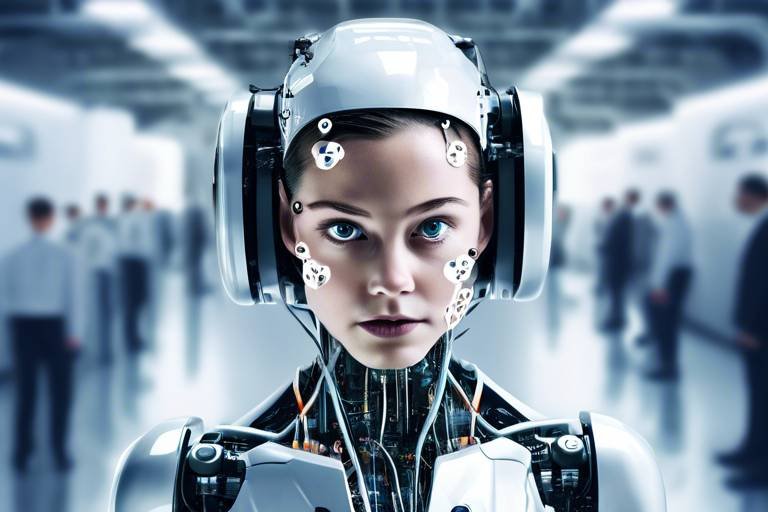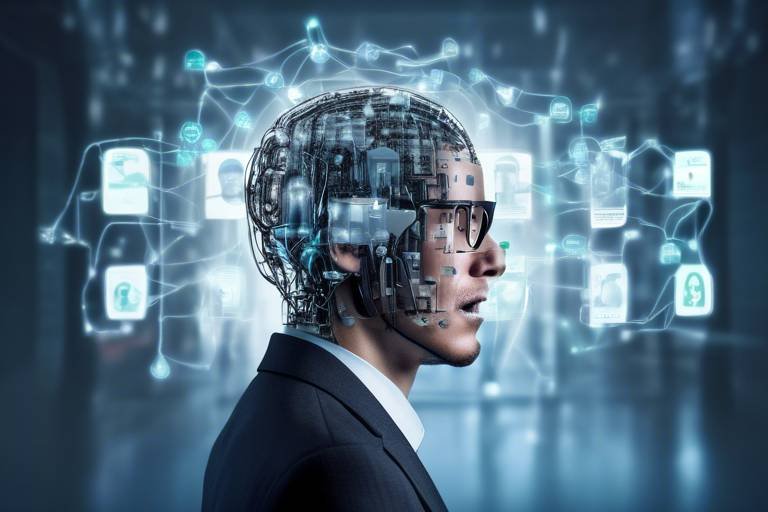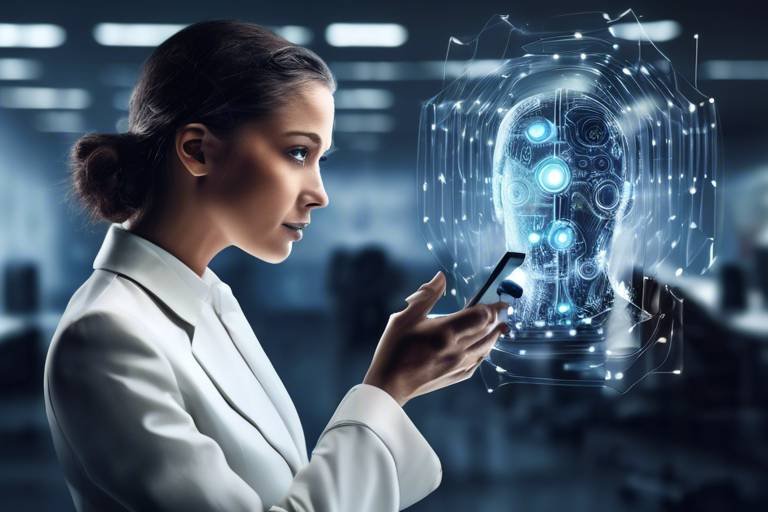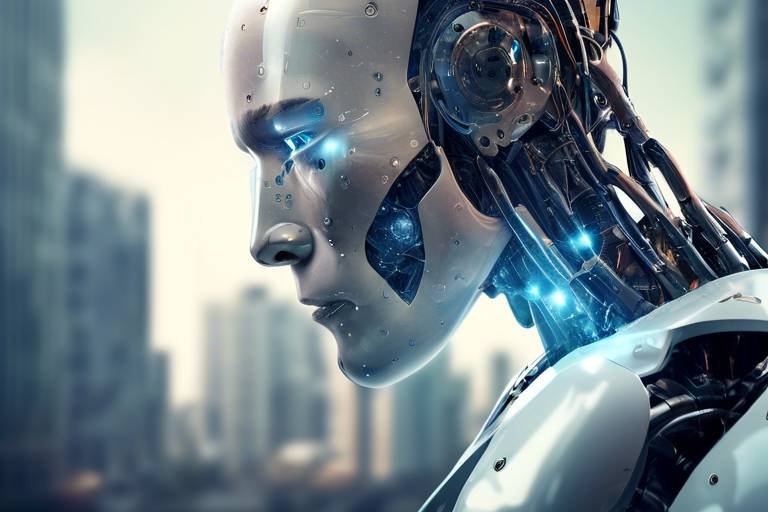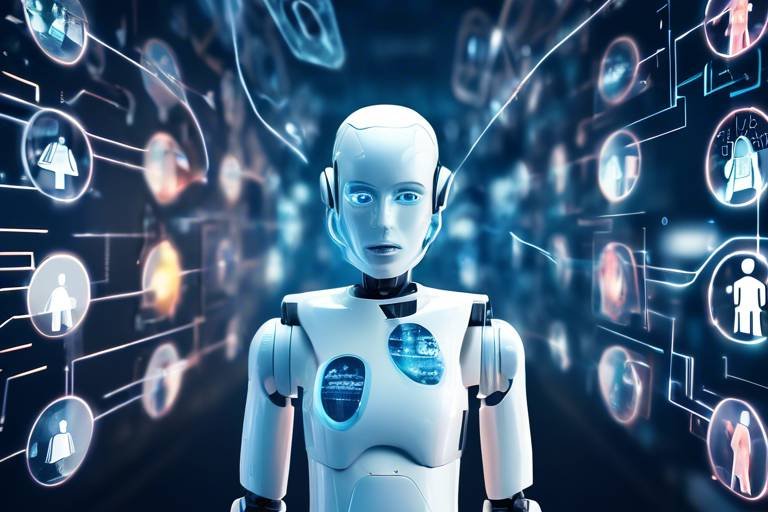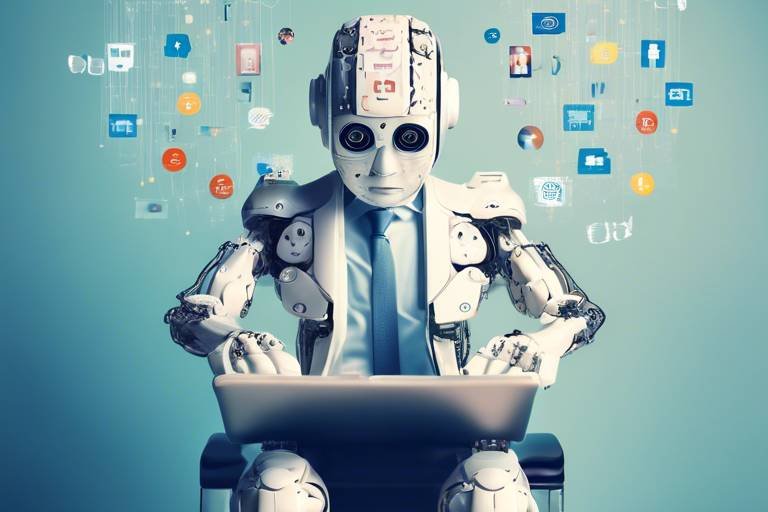The Role of Artificial Intelligence in the Future Workplace
Artificial Intelligence (AI) is no longer just a concept from science fiction; it has become a reality that is reshaping our workplaces in profound ways. Imagine walking into an office where mundane tasks are handled effortlessly by machines, allowing employees to focus on what truly matters—innovation, creativity, and strategic thinking. This transformation is not just about replacing human effort; it’s about enhancing productivity and redefining job roles across various industries. As we delve into this exciting evolution, it’s essential to consider how AI is not only changing the way we work but also how we think about work itself.
In the coming sections, we will explore the multifaceted impact of AI on recruitment, employee productivity, training, and the future of job roles. We will also touch on ethical considerations that arise as AI becomes more integrated into our daily work lives. Are we ready to embrace this change? Or do we need to tread carefully as we navigate the complexities of an AI-driven workplace? Let’s dive deeper into these questions and discover the implications for employees and organizations alike.
AI is revolutionizing the recruitment process by streamlining candidate selection and improving the quality of hires. Traditionally, recruitment has been a labor-intensive process, often plagued by biases and inefficiencies. However, with the advent of AI tools, organizations can now leverage algorithms to sift through thousands of resumes in a fraction of the time it would take a human recruiter. This not only enhances efficiency but also leads to better hiring decisions.
Moreover, AI can analyze candidate data to identify the best fits for specific roles, taking into account various factors like skills, experience, and cultural fit. Imagine a world where the perfect candidate is matched with the perfect job, all thanks to sophisticated AI algorithms. This is not just a dream; it's becoming a reality.
Artificial intelligence tools are designed to assist employees in their tasks, leading to increased productivity. By automating repetitive tasks, AI frees up valuable time for employees to focus on more strategic work. For instance, AI can handle data entry, scheduling, and even customer inquiries, allowing employees to engage in higher-order thinking and creativity.
Think about the countless hours spent on mundane tasks—sorting emails, filing reports, or even organizing meetings. AI can automate these processes, dramatically changing daily workflows. This shift not only enhances productivity but also improves job satisfaction as employees can engage in more meaningful work.
Task automation through AI leads to significant benefits, including:
- Time Savings: Employees can allocate more time to strategic initiatives rather than getting bogged down by routine tasks.
- Reduced Human Error: AI systems can perform tasks with a high degree of accuracy, minimizing mistakes.
- Increased Job Satisfaction: By removing tedious tasks, employees can focus on work that they find more fulfilling.
While automation offers many advantages, it also presents challenges, such as job displacement. As AI takes over routine tasks, there are legitimate concerns about job loss in certain sectors. However, it’s crucial to view this not as a threat but as an opportunity for employees to upskill and adapt to new roles that AI cannot fulfill.
AI systems are increasingly used to analyze data and support decision-making processes. By processing vast amounts of information quickly and accurately, AI can provide insights that help organizations make informed strategic decisions. This capability enhances not only operational efficiency but also the overall agility of businesses in responding to market changes.
AI is transforming employee training programs by providing personalized learning experiences. Traditional training methods often adopt a one-size-fits-all approach, which can leave many employees disengaged. AI, however, can tailor training modules to fit the unique needs and skills of each employee, ensuring that everyone receives the training they need to succeed.
AI can create customized learning paths for employees based on their current skills, career goals, and performance metrics. This personalization not only boosts engagement but also enhances the effectiveness of training programs, leading to a more skilled workforce.
Combining AI with virtual reality offers immersive training experiences that can significantly enhance learning outcomes. Imagine a sales team practicing their pitches in a simulated environment where they can receive real-time feedback from an AI coach. This innovative approach to training is reshaping how employees develop their skills.
As AI continues to evolve, job roles will adapt accordingly. While some positions may become obsolete, new roles are emerging that require human-AI collaboration. This shift is not just about technology; it’s about rethinking how we define work and the skills needed to thrive in this new landscape.
While some jobs may be replaced by AI, new roles are emerging that require human-AI collaboration. Positions such as AI trainers, data analysts, and AI ethics compliance officers are just a few examples of career paths that are gaining traction in an AI-driven workplace.
The integration of AI in the workplace necessitates a shift in the skills employees need. Skills such as critical thinking, creativity, and emotional intelligence will become increasingly valuable as machines take over more routine tasks. Embracing lifelong learning will be essential for anyone looking to thrive in this evolving landscape.
The rise of AI in the workplace brings ethical concerns that must be addressed. Issues surrounding privacy, bias, and job security are increasingly coming to the forefront as organizations adopt AI technologies. It’s vital to ensure that as we embrace these advancements, we also consider their implications on our workforce.
AI systems can inadvertently perpetuate biases present in training data. Ensuring fairness in AI applications is crucial to avoid discrimination in hiring, promotions, and other employment practices. Organizations must actively work to identify and mitigate these biases to create a more equitable workplace.
With the increased use of AI comes heightened concerns about data privacy. Organizations must navigate the challenges of maintaining employee privacy while utilizing AI tools that often require access to sensitive information. Establishing clear policies and practices for data handling will be essential in building trust with employees.
In conclusion, AI is poised to significantly impact the future workplace, offering both opportunities and challenges. As we embrace this technology, it’s essential to remain mindful of the ethical implications and the evolving nature of job roles. The future of work in an AI era is not just about technology; it’s about people, skills, and the values we uphold as we navigate this exciting transformation.
- How will AI affect job security?
AI may lead to job displacement in some sectors, but it will also create new opportunities that require human skills. - What skills will be most valuable in an AI-driven workplace?
Skills like critical thinking, creativity, and emotional intelligence will be increasingly important as AI takes over routine tasks. - How can organizations ensure ethical AI use?
By actively addressing bias, ensuring data privacy, and promoting transparency in AI applications.

AI in Recruitment
Artificial Intelligence (AI) is revolutionizing the recruitment landscape, transforming how companies identify, evaluate, and hire talent. Imagine walking into a world where your resume is not just a piece of paper, but a data-rich profile that AI sifts through in seconds, pinpointing the perfect candidates for a role. This is not science fiction; it’s the reality of modern hiring practices. AI tools are enhancing efficiency and improving the quality of hires, making the recruitment process not only faster but also smarter.
One of the most significant advantages of AI in recruitment is its ability to analyze vast amounts of data quickly. Traditional recruitment methods often involve manual screening of resumes, which can be time-consuming and prone to human error. However, with AI-powered tools, employers can automate the initial screening process. These systems utilize algorithms to evaluate candidates based on their skills, experiences, and even cultural fit. This means that hiring managers can focus on the most promising candidates, leading to a more effective recruitment process.
Moreover, AI can help eliminate biases that may unconsciously affect hiring decisions. By standardizing the evaluation criteria, AI can ensure that candidates are assessed purely on their qualifications and potential, rather than subjective factors. For example, AI systems can anonymize resumes, removing names and other identifiers that might lead to bias, thus promoting a more diverse workforce. This capability not only enhances fairness in hiring but also enriches the workplace with varied perspectives and ideas.
Additionally, AI tools can provide valuable insights into the recruitment process. By analyzing data from past hiring decisions, AI can identify trends and patterns that inform future strategies. For instance, if a company consistently hires successful employees from a particular university or background, AI can highlight this information, enabling recruiters to target similar candidates in future searches. This data-driven approach not only streamlines recruitment but also enhances the quality of hires.
However, as with any technological advancement, there are challenges to consider. Some candidates may feel uneasy about being evaluated by algorithms, fearing that they may not receive a fair chance. It’s crucial for organizations to communicate transparently about how AI is used in their recruitment processes. A clear understanding can help alleviate concerns and foster trust among applicants.
In conclusion, AI is not just a trend; it’s a transformative force in recruitment, reshaping how organizations find and hire talent. By leveraging AI tools, companies can enhance efficiency, reduce bias, and make more informed hiring decisions. As we move forward, embracing these technologies will be essential for staying competitive in the ever-evolving job market.
- How does AI improve the recruitment process?
AI improves the recruitment process by automating resume screening, reducing bias, and providing data-driven insights that help recruiters make informed decisions. - Are AI tools biased?
While AI aims to reduce bias, it can inadvertently perpetuate biases present in the training data. It's essential for companies to monitor and adjust their AI systems to ensure fairness. - Can candidates trust AI in recruitment?
Transparency in how AI is used can help build trust. Candidates should be informed about the evaluation criteria and how their data will be used. - Will AI replace human recruiters?
AI is designed to assist human recruiters, not replace them. The human touch in recruitment is irreplaceable, especially when it comes to assessing cultural fit and soft skills.

Enhancing Employee Productivity
In today's fast-paced work environment, enhancing employee productivity has become a top priority for organizations. With the advent of artificial intelligence (AI), companies are finding innovative ways to streamline operations and empower their workforce. Imagine a world where employees can focus on creative problem-solving while AI handles the mundane tasks. Sounds like a dream, right? Well, it's becoming a reality!
AI tools are specifically designed to assist employees in their daily tasks, leading to a remarkable increase in overall productivity. For instance, AI-powered software can analyze vast amounts of data in seconds, allowing employees to make informed decisions without spending hours sifting through information. This not only saves time but also enhances the quality of the work being produced.
Moreover, the integration of AI into workplace processes can significantly reduce the cognitive load on employees. By automating repetitive tasks, AI frees up valuable mental resources, enabling employees to concentrate on more strategic initiatives. Consider this: if an employee spends 30% of their time on repetitive tasks, what could they achieve if that time was redirected towards innovation and collaboration?
One of the most impactful applications of AI in the workplace is the automation of repetitive tasks. This includes everything from data entry to scheduling meetings. With AI handling these mundane responsibilities, employees can redirect their energy towards tasks that require human creativity and critical thinking. For example, customer service representatives can use AI chatbots to manage common inquiries, allowing them to focus on complex customer issues that require a personal touch.
The benefits of automating routine responsibilities are manifold:
- Time Savings: Employees can complete tasks faster, leading to higher output.
- Reduced Human Error: Automation minimizes the risk of mistakes that can occur with manual processes.
- Increased Job Satisfaction: Employees often report higher job satisfaction when they can engage in more meaningful work.
While task automation offers numerous advantages, it also presents challenges. One of the most pressing concerns is job displacement. As AI systems take over routine tasks, some roles may become obsolete. However, it’s essential to view this change as an opportunity for growth rather than a threat. Organizations must invest in reskilling their workforce to adapt to new roles that AI cannot fulfill.
Additionally, there is a need for a cultural shift within companies to embrace AI as a partner rather than a competitor. By fostering a collaborative environment where humans and AI work side by side, organizations can harness the full potential of both.
Another way AI enhances employee productivity is through AI-powered decision-making systems. These systems can analyze data trends and provide insights that help employees make more informed decisions. For instance, in marketing, AI can analyze customer behavior and preferences, enabling teams to tailor their campaigns effectively. This not only boosts productivity but also enhances the overall success rate of projects.
In conclusion, AI is not just a technological advancement; it's a game changer in how we approach work. By enhancing productivity through automation and informed decision-making, AI is paving the way for a more efficient and innovative workplace. As we continue to integrate these tools into our daily routines, the future of work looks brighter than ever.
Q1: How does AI improve employee productivity?
A1: AI improves productivity by automating repetitive tasks, allowing employees to focus on more strategic work and decision-making processes.
Q2: What are the potential downsides of using AI in the workplace?
A2: Potential downsides include job displacement and the need for employees to adapt to new roles and responsibilities as automation increases.
Q3: How can companies ensure a smooth transition to an AI-enhanced workplace?
A3: Companies can ensure a smooth transition by investing in employee training, fostering a culture of collaboration, and clearly communicating the benefits of AI integration.

Automation of Repetitive Tasks
In today's fast-paced work environment, the has emerged as a game-changer. Imagine a world where employees can focus their creativity and strategic thinking on projects that truly matter, while mundane tasks are handled seamlessly by artificial intelligence (AI) systems. This shift is not just a dream; it's happening right now, and it’s reshaping how we work.
AI technologies are designed to take over those repetitive, time-consuming tasks that often bog down productivity. From data entry and scheduling to basic customer service inquiries, automation is freeing up valuable time for employees to engage in more meaningful work. For instance, consider how AI chatbots can handle customer queries 24/7, allowing human employees to concentrate on complex issues that require a personal touch.
Here’s a closer look at some of the tasks AI can automate:
- Data Entry: AI can input, update, and manage data across various platforms, reducing the risk of human error.
- Scheduling: Automated scheduling tools can find available times for meetings, eliminating the back-and-forth emails.
- Report Generation: AI can pull data and generate reports in real-time, saving hours of manual work.
By automating these repetitive tasks, companies not only enhance productivity but also improve employee satisfaction. Nobody enjoys spending hours on tasks that don’t require deep thought or creativity. When employees can redirect their energy towards innovative projects, it leads to a more engaged and motivated workforce. Additionally, the reduction in monotonous tasks can significantly lower stress levels, contributing to a healthier work environment.
However, it's essential to recognize that the automation of tasks does come with its challenges. Some employees may feel threatened by the technology, fearing job loss or displacement. It’s crucial for organizations to communicate the benefits of automation clearly, emphasizing that the goal is not to replace humans but to enhance their capabilities. By fostering a culture of collaboration between humans and AI, companies can ensure a smoother transition into this new era of work.
As we look to the future, the role of AI in automating repetitive tasks will only grow. Businesses that embrace this transformation will not only thrive but will also set new standards for efficiency and employee satisfaction. So, the next time you find yourself bogged down by repetitive tasks, remember that AI is here to help you soar to new heights!
- What types of tasks can AI automate? AI can automate a variety of tasks, including data entry, scheduling, report generation, and customer service inquiries.
- Will AI replace human jobs? While some jobs may be affected, AI is more likely to enhance human roles by taking over repetitive tasks, allowing employees to focus on more strategic work.
- How can companies implement AI for automation? Companies can start by identifying repetitive tasks within their operations and exploring AI tools that can efficiently handle those tasks.

Benefits of Task Automation
Task automation, powered by artificial intelligence, is rapidly becoming a game changer in the workplace. Imagine a world where tedious, repetitive tasks are handled by machines, freeing up valuable time for employees to focus on more meaningful and strategic work. This transformation is not just a dream; it’s happening right now! By automating mundane tasks, organizations can reap a multitude of benefits that enhance overall productivity and employee satisfaction.
One of the most significant advantages of task automation is the time savings it offers. Employees often find themselves bogged down by routine responsibilities that consume hours each week. By utilizing AI to take over these tasks, companies can unlock precious hours that can be redirected towards creative problem-solving and innovation. For instance, automating data entry or scheduling can save employees from the drudgery of these tasks, allowing them to engage in projects that require critical thinking.
Moreover, automation leads to a reduction in human error. In any workplace, mistakes can be costly—financially and reputationally. AI systems, when programmed correctly, perform tasks with a level of precision that humans simply cannot match. For example, in industries like finance or healthcare, where accuracy is paramount, automating calculations or patient record management can significantly decrease the likelihood of errors. This not only enhances the quality of work but also builds trust with clients and stakeholders.
Another compelling benefit is the enhancement of employee morale. Let’s face it: no one enjoys performing repetitive tasks day in and day out. By automating these responsibilities, employees can engage in more fulfilling work that aligns with their skills and interests. This shift can lead to increased job satisfaction, higher retention rates, and a more positive workplace culture overall. When employees feel valued and challenged, they are more likely to contribute meaningfully to the organization.
Additionally, task automation can improve scalability for businesses. As companies grow, the volume of work often increases exponentially. Automation allows organizations to scale operations without necessarily increasing headcount. For example, a customer service department can implement AI chatbots to handle common inquiries, thus managing higher volumes of customer interactions without overwhelming human staff. This adaptability is crucial in today’s fast-paced business environment.
In summary, the benefits of task automation are substantial and multifaceted. By embracing AI technologies, organizations can enhance productivity, reduce errors, boost employee morale, and achieve greater scalability. As we move forward in this digital age, the question isn’t whether to automate, but rather how to do it effectively to maximize these benefits.
- What tasks can be automated in the workplace? Many tasks can be automated, including data entry, scheduling, customer service inquiries, and inventory management.
- Will automation replace human jobs? While some jobs may be at risk, automation also creates new roles that require human-AI collaboration, focusing on oversight and strategic decision-making.
- How can I implement task automation in my organization? Start by identifying repetitive tasks that consume significant time and explore AI tools that can automate these processes effectively.
- What are the potential downsides of task automation? Challenges include potential job displacement, initial implementation costs, and the need for ongoing maintenance and updates of AI systems.

Challenges of Automation
While automation through artificial intelligence (AI) offers a plethora of benefits, it also comes with its own set of challenges that cannot be ignored. One of the most pressing issues is the potential for job displacement. As machines take over repetitive and mundane tasks, many employees may find their roles becoming obsolete. This shift raises questions about workforce re-skilling and the need for organizations to invest in training programs that help employees transition into new roles that complement AI technologies.
Moreover, there is a significant concern regarding the quality of work produced by automated systems. While AI can process data and perform tasks with remarkable speed, it lacks the human touch that is often essential in creative and nuanced decision-making scenarios. For instance, in fields like marketing or customer service, a human's ability to empathize and connect with clients can be irreplaceable. Relying too heavily on automation could lead to a decline in customer satisfaction and engagement.
Another challenge is the initial cost of implementation. Integrating AI solutions into existing workflows often requires substantial financial investment. Companies must consider not only the cost of the technology itself but also the expenses related to training employees to use these new systems effectively. For small businesses, this can be a daunting barrier to entry, potentially widening the gap between larger corporations that can afford to invest in AI and smaller firms that struggle to keep up.
Furthermore, there are ethical concerns surrounding automation, particularly when it comes to bias and fairness. AI systems learn from historical data, which can sometimes contain biases that are inadvertently perpetuated in automated decision-making processes. This can lead to unfair treatment of certain groups within the workforce and can also affect hiring practices. Organizations must be vigilant in monitoring their AI systems to ensure they do not inadvertently reinforce existing inequalities.
Lastly, the loss of human oversight can be a double-edged sword. While automation can free up employees to focus on more strategic tasks, it can also lead to a scenario where critical decisions are made without adequate human input. This lack of oversight can result in mistakes that, while they may be rare, can have significant consequences. Companies must find the right balance between leveraging AI for efficiency and maintaining human involvement in important decision-making processes.
In summary, while automation presents exciting opportunities for enhancing productivity and efficiency in the workplace, it is crucial to address these challenges head-on. Organizations must be proactive in developing strategies that not only embrace AI but also consider the implications for their workforce, ensuring a smooth transition into an increasingly automated future.
- What are the main challenges of AI automation? The main challenges include job displacement, quality of work, cost of implementation, bias in decision-making, and loss of human oversight.
- How can companies mitigate job displacement due to automation? Companies can invest in training and reskilling programs to help employees transition into new roles that complement AI technologies.
- What ethical concerns are associated with AI automation? Ethical concerns include bias in AI systems, privacy issues, and the potential for unfair treatment of employees.
- Is AI automation expensive to implement? Yes, implementing AI automation can require significant financial investment, including technology costs and training expenses.

AI-Powered Decision Making
In today's fast-paced business environment, the ability to make informed decisions quickly can be the difference between success and failure. Enter artificial intelligence—a game-changer in the realm of decision-making. AI systems are increasingly being integrated into organizations to analyze vast amounts of data, providing insights that would be impossible for humans to uncover alone. Imagine having a supercharged assistant that sifts through mountains of information, identifying trends, patterns, and anomalies at lightning speed. This is exactly what AI does, and it’s transforming the way companies operate.
One of the most significant advantages of AI in decision-making is its ability to process data from various sources simultaneously. For instance, AI can analyze customer feedback, sales reports, market trends, and even social media sentiments all at once. This multi-faceted approach allows businesses to gain a comprehensive understanding of their environment, leading to better strategic planning. Think of it as having a 360-degree view of your business landscape, where every angle is covered, and no detail is overlooked.
Moreover, AI can help eliminate human biases that often cloud judgment. Traditional decision-making processes can be influenced by emotions, personal experiences, or even groupthink. However, AI relies on data-driven algorithms that focus solely on facts. This means that decisions made with the assistance of AI are more likely to be objective and based on solid evidence. To illustrate this, consider the following table that compares traditional decision-making with AI-powered decision-making:
| Aspect | Traditional Decision-Making | AI-Powered Decision-Making |
|---|---|---|
| Data Processing | Manual analysis, time-consuming | Automated analysis, real-time |
| Bias | Subjective, prone to human error | Objective, data-driven |
| Speed | Slower, dependent on human resources | Faster, leveraging machine learning |
| Outcome Quality | Variable, based on individual judgment | Consistent, based on comprehensive data |
As organizations continue to adopt AI technologies, the potential for enhanced decision-making becomes even more pronounced. AI can provide predictive analytics, allowing businesses to foresee potential challenges and opportunities. For example, a retail company might use AI to predict inventory needs based on seasonal trends, ensuring they stock just the right amount of products to meet customer demand without overextending resources.
However, it's essential to recognize that while AI can significantly enhance decision-making, it should not be viewed as a replacement for human intuition and experience. The best outcomes often arise from a collaborative approach where AI tools complement human insight. After all, AI is a tool designed to aid us, not replace our unique capabilities.
In conclusion, AI-powered decision-making is reshaping how organizations approach challenges and opportunities. By leveraging data analytics, removing bias, and speeding up processes, AI enables businesses to make smarter, more informed decisions. As we continue to embrace this technology, the future of decision-making looks not just brighter, but also more precise and impactful.
- What are the main benefits of AI in decision-making? AI enhances speed, accuracy, and objectivity in decision-making processes.
- Can AI replace human decision-makers? No, AI serves as a tool to assist humans, combining data analysis with human intuition.
- How does AI eliminate biases in decision-making? AI relies on data-driven algorithms that focus on facts rather than emotions or personal experiences.
- What industries benefit most from AI-powered decision-making? Industries such as finance, healthcare, retail, and logistics are seeing significant improvements through AI integration.

AI in Employee Training
Artificial Intelligence (AI) is not just a buzzword; it's a game-changer in the realm of employee training. Imagine a workplace where training is not a one-size-fits-all approach but a tailored experience designed specifically for each employee’s unique needs. With AI, this vision is becoming a reality. AI-powered training programs can analyze an employee's performance, identify skill gaps, and develop personalized learning paths that cater to individual strengths and weaknesses. This means that employees are not wasting time on content that doesn't apply to them, making training more efficient and engaging.
But how exactly does AI facilitate this transformation? First, let's consider the concept of personalized learning paths. AI algorithms can sift through vast amounts of data to create customized training modules. For example, if an employee excels in analytical skills but struggles with communication, the AI can prioritize training that focuses on enhancing communication abilities while allowing the employee to progress at their own pace in areas where they are already proficient. This tailored approach not only boosts confidence but also leads to better retention of knowledge.
Moreover, the integration of AI with virtual reality (VR) is revolutionizing the training landscape. Traditional training methods often fall short in providing immersive experiences. However, with AI-enhanced VR training, employees can engage in realistic simulations that mimic real-world scenarios. This hands-on experience allows them to practice skills in a safe environment, making mistakes without the fear of real-world repercussions. For instance, a customer service representative can practice handling difficult customers through a VR simulation, gaining valuable experience before facing actual clients.
In addition to personalized learning and immersive training, AI can also facilitate ongoing assessments. Imagine receiving instant feedback on your performance after completing a training module. AI can evaluate responses, identify areas for improvement, and suggest additional resources. This continuous feedback loop ensures that employees are always progressing and not just completing training for the sake of it. It creates an environment where learning is a constant journey rather than a destination.
However, it’s essential to recognize that while AI offers numerous advantages in employee training, it also raises questions about the balance between technology and human interaction. Training should not solely rely on AI; human trainers bring invaluable insights and emotional intelligence that machines cannot replicate. Therefore, the best approach is a hybrid model that combines AI's efficiency with the personal touch of human trainers.
As we look to the future, the role of AI in employee training will continue to evolve. Organizations that embrace these technologies will not only enhance their training programs but also foster a culture of continuous learning. By investing in AI-driven training solutions, companies can ensure that their workforce remains competitive and well-equipped to tackle the challenges of tomorrow.
- How does AI personalize employee training? AI analyzes individual performance data and skill gaps to create customized training modules tailored to each employee's needs.
- What role does virtual reality play in AI training? Virtual reality provides immersive training experiences, allowing employees to practice skills in realistic simulations.
- Can AI replace human trainers? No, while AI can enhance training, human trainers provide essential emotional intelligence and insights that technology cannot replicate.
- What are the benefits of continuous feedback in training? Continuous feedback helps employees identify areas for improvement and ensures they are always progressing in their learning journey.

Personalized Learning Paths
In today's fast-paced work environment, the traditional one-size-fits-all training approach is becoming obsolete. Enter , a game-changer in employee development that leverages the power of artificial intelligence. Imagine walking into a training session where the content is tailored specifically to your unique skill set and career aspirations. Sounds appealing, right? This is precisely what AI can offer! By analyzing an employee's previous performance, current competencies, and future goals, AI can curate a learning experience that meets individual needs.
These personalized paths often include a variety of learning methods, such as online courses, interactive modules, and hands-on workshops. For instance, if an employee excels in technical skills but struggles with communication, the AI system might prioritize training in soft skills while still providing advanced technical courses. This targeted approach not only enhances the learning experience but also fosters a sense of ownership and motivation among employees.
Moreover, personalized learning paths can adapt in real-time. As employees progress, the AI can reassess their skills and adjust the training modules accordingly. This dynamic feedback loop ensures that employees are always engaged with relevant content that challenges them without overwhelming them. It's like having a personal trainer for your career!
| Key Features of Personalized Learning Paths | Benefits |
|---|---|
| Tailored Content | Improves engagement and retention of information. |
| Adaptive Learning | Ensures continuous growth and development. |
| Diverse Learning Formats | Caters to different learning styles, enhancing effectiveness. |
| Real-time Feedback | Allows for immediate adjustments to learning paths. |
Additionally, organizations can benefit significantly from implementing personalized learning paths. Companies that invest in customized training programs often see higher employee satisfaction, lower turnover rates, and improved overall performance. When employees feel that their personal growth is valued, they are more likely to stay engaged and committed to their roles.
In conclusion, personalized learning paths powered by AI are not just a trend; they are the future of workplace training. By focusing on individual needs and preferences, organizations can cultivate a more skilled, motivated, and satisfied workforce ready to tackle the challenges of tomorrow.
- What are personalized learning paths? Personalized learning paths are customized training programs designed to meet the individual needs, skills, and career goals of employees, often facilitated by AI.
- How does AI contribute to personalized learning? AI analyzes employee data to create tailored training experiences that adapt in real-time based on progress and performance.
- What are the benefits of personalized learning paths for organizations? Benefits include higher employee engagement, improved retention rates, and enhanced overall performance.
- Can personalized learning paths accommodate different learning styles? Yes, they often include various formats such as online courses, workshops, and interactive modules to cater to diverse learning preferences.

Virtual Reality Training
Imagine stepping into a world where you can practice your skills without the fear of making mistakes in real life. Virtual Reality (VR) training offers just that—a safe, immersive environment where employees can hone their skills, learn new techniques, and experience scenarios that are otherwise difficult to replicate. This innovative approach is transforming how organizations train their workforce, making learning not just effective but also engaging.
One of the most exciting aspects of VR training is its ability to simulate real-world situations. For instance, a medical professional can practice complex surgical procedures in a virtual operating room, allowing them to refine their skills before they ever touch a patient. Similarly, a firefighter can face simulated emergency situations that prepare them for the unpredictability of their job. The applications are vast and varied, and they cater to numerous industries, including healthcare, construction, and customer service.
Moreover, VR training is not just about replicating real-life scenarios; it also enhances retention. Studies have shown that immersive experiences can significantly improve memory recall. When employees engage with training content in a 3D environment, they are more likely to remember what they learned compared to traditional training methods. This is because VR taps into multiple senses, creating a richer learning experience that sticks with individuals long after the training session is over.
Another key benefit of VR training is its ability to provide immediate feedback. In a VR setting, employees can receive instant evaluations on their performance, allowing them to adjust their techniques on the spot. This real-time feedback loop is crucial for skill development, as it helps trainees identify areas for improvement without the pressure of a live environment. For example, a sales representative can practice their pitch in a virtual setting, receiving constructive criticism that they can apply immediately to improve their approach.
However, implementing VR training does come with its challenges. Organizations must invest in the right technology and software to create effective training modules. Additionally, there is a learning curve for both trainers and employees to become comfortable with the technology. Yet, the investment can yield significant returns in terms of employee preparedness and confidence. As VR technology continues to advance, the potential for even more sophisticated training experiences will only grow.
In conclusion, is revolutionizing how organizations approach employee development. By providing immersive, engaging, and effective training experiences, companies can prepare their workforce for the challenges of the future. As industries continue to evolve, embracing VR training could be the key to staying ahead of the curve in a rapidly changing job landscape.
- What industries benefit from VR training?
VR training is beneficial across various industries, including healthcare, construction, aviation, and customer service, where realistic simulations can enhance learning outcomes.
- How does VR training improve retention?
VR training enhances retention by creating immersive experiences that engage multiple senses, making it easier for learners to remember the material presented.
- What are the challenges of implementing VR training?
Challenges include the initial investment in technology, the need for software development, and the learning curve associated with using VR tools effectively.

The Future of Job Roles
As we stand on the brink of a technological revolution, the future of job roles is evolving in ways we could only dream of a decade ago. With the rise of artificial intelligence (AI), traditional job descriptions are being rewritten, and new roles are emerging that demand a unique blend of human creativity and technological prowess. It's like watching a caterpillar transform into a butterfly; the workplace is shedding its old skin and embracing a vibrant new identity.
One of the most fascinating aspects of this transformation is the collaboration between humans and AI. Rather than completely replacing human workers, AI is designed to augment their capabilities. For instance, in industries like healthcare, AI systems can analyze medical data faster than any human, yet it still requires a skilled doctor to interpret those results and make critical decisions. This synergy creates a new job landscape where roles are more about enhancing human abilities than merely performing tasks.
As we navigate this new terrain, it's essential to recognize the emerging job opportunities that AI is creating. While some positions may become obsolete, others are being born from the ashes. For example, jobs such as AI trainers, data analysts, and even AI ethics compliance officers are becoming increasingly relevant. Here’s a quick look at some of these roles:
| Job Title | Description | Skills Required |
|---|---|---|
| AI Trainer | Responsible for training AI systems to improve their performance. | Understanding of AI models, data analysis, and programming. |
| Data Analyst | Analyzes data to provide insights and support decision-making. | Statistical analysis, data visualization, and critical thinking. |
| AI Ethics Compliance Officer | Ensures AI systems are used ethically and comply with regulations. | Knowledge of AI ethics, legal frameworks, and communication skills. |
Moreover, the integration of AI is reshaping the skills landscape. As job roles evolve, so too must the skills required to perform them. Employees will need to cultivate a mix of technical skills and soft skills. Technical skills might include proficiency in data analytics or machine learning, while soft skills could encompass creativity, adaptability, and emotional intelligence. It’s a bit like being a Swiss Army knife; the more tools you have, the more versatile you become in the workplace.
However, this shift doesn’t come without its challenges. Many workers may feel apprehensive about the rapid changes, fearing job displacement or the need to acquire new skills quickly. It's crucial for organizations to support their employees through this transition. Offering training programs, mentorship, and resources can help ease the anxiety surrounding these changes and empower employees to thrive in an AI-enhanced environment.
In conclusion, the future of job roles is not just about the threat of automation but also about the incredible opportunities that lie ahead. By embracing AI and adapting to the new landscape, both employees and organizations can harness the power of technology to create a more dynamic and fulfilling workplace.
- Will AI take away all jobs? No, while some jobs may be automated, many new roles will emerge that require human skills.
- What skills will be most valuable in an AI-driven workplace? Skills in data analysis, programming, and soft skills like creativity and adaptability will be crucial.
- How can employees prepare for changes in their job roles? Employees can engage in continuous learning and seek training programs to upskill as needed.

Emerging Job Opportunities
As we stand on the brink of a new era defined by artificial intelligence, the job market is experiencing a significant transformation. While some traditional roles may fade into obscurity, a plethora of are sprouting up, requiring a unique blend of human skills and AI capabilities. Think of it as a garden where, as old plants wither away, new ones bloom, bringing fresh possibilities for growth and innovation.
One fascinating aspect of this shift is the rise of positions that focus on human-AI collaboration. As organizations increasingly integrate AI into their operations, the demand for professionals who can bridge the gap between technology and human insight is skyrocketing. These roles often involve working alongside AI systems to enhance decision-making processes, optimize workflows, and drive strategic initiatives. For instance, consider the role of an AI Ethicist, a position that aims to ensure ethical practices in AI deployment, addressing concerns like bias and privacy.
Moreover, we are witnessing the emergence of jobs that require specialized knowledge in AI technologies. Positions such as Machine Learning Engineers and Data Scientists are in high demand, as organizations seek individuals who can develop and refine AI algorithms. These professionals play a crucial role in extracting insights from vast amounts of data, ensuring that AI systems operate effectively and ethically.
Additionally, the healthcare sector is also seeing a surge in opportunities driven by AI advancements. Roles like Health Informatics Specialists are becoming essential as they leverage AI tools to improve patient care and streamline operations. These specialists analyze data to inform treatment plans, enhance patient outcomes, and reduce costs, making them invaluable in the evolving healthcare landscape.
Furthermore, the creative industries are not immune to this transformation. We are beginning to see the rise of AI Content Creators, professionals who use AI tools to generate written content, design graphics, or even compose music. This blend of creativity and technology opens up exciting avenues for artists and marketers alike, allowing them to harness AI to enhance their creative processes.
In summary, while the fear of job displacement looms large, the reality is that new roles are emerging that reflect the changing dynamics of the workplace. The key takeaway is that adaptability and a willingness to learn are essential in this evolving environment. As we embrace these changes, it's important to stay informed about the skills and knowledge required for these new opportunities.
- What types of jobs are emerging due to AI? Many new roles are focused on human-AI collaboration, data analysis, and creative content generation.
- How can I prepare for a job in an AI-driven workplace? Building skills in data analysis, machine learning, and ethical AI practices can be beneficial.
- Will AI replace all jobs? While some jobs may be automated, many new opportunities will arise that require human skills and oversight.

Skills for the Future
As we step into the era of artificial intelligence, the landscape of job roles and required skills is shifting dramatically. The integration of AI in the workplace is not just a trend; it's a revolution that demands a new set of competencies from employees. So, what does this mean for you as a worker in this evolving environment? Well, it’s time to adapt and embrace a mindset geared towards continuous learning and adaptability.
One of the most crucial skills for the future is digital literacy. In a world where technology is omnipresent, being comfortable with various digital tools and platforms is essential. This goes beyond just knowing how to use software; it includes understanding how to leverage data and interpret analytics to make informed decisions. Companies are increasingly looking for employees who can navigate the digital landscape with ease, making digital literacy a non-negotiable skill.
Another vital skill is critical thinking. As AI takes over more routine tasks, the ability to analyze information, evaluate options, and make sound judgments becomes paramount. Employers are seeking individuals who can think outside the box and approach problems with a creative mindset. This skill is especially important in roles that require strategic planning and decision-making, where human intuition and insight are irreplaceable.
Furthermore, emotional intelligence is becoming increasingly valuable. In an AI-driven workplace, where machines handle many operational tasks, the human touch remains irreplaceable. The ability to understand and manage one’s emotions, as well as empathize with others, is essential for effective teamwork and leadership. Companies are recognizing that while AI can analyze data, it cannot replicate the nuanced understanding of human emotions and relationships.
Lastly, collaboration skills are essential in a future where human-AI collaboration is the norm. Employees must be able to work effectively with AI systems and with each other, often in diverse teams. This requires excellent communication skills, adaptability, and a willingness to learn from both humans and machines. As organizations become more interconnected and reliant on technology, the ability to collaborate across disciplines will be a significant asset.
In summary, the skills required for the future workplace encompass a blend of technical know-how, critical thinking, emotional intelligence, and collaboration. As we embrace this new frontier, investing in these skills will not only enhance your employability but also prepare you for a fulfilling career in an AI-enhanced world.
- What are the most important skills to develop for future jobs? The most important skills include digital literacy, critical thinking, emotional intelligence, and collaboration skills.
- How can I improve my digital literacy? You can improve your digital literacy by taking online courses, attending workshops, and practicing with various digital tools and platforms.
- Why is emotional intelligence important in the workplace? Emotional intelligence is crucial for effective communication, teamwork, and leadership, especially in an environment where human interactions are key to success.
- What role does collaboration play in an AI-driven workplace? Collaboration is essential as employees will need to work together and with AI systems to achieve organizational goals effectively.

Ethical Considerations
The rise of artificial intelligence (AI) in the workplace is not just a technological revolution; it also brings with it a host of that organizations must navigate. As AI systems become more integrated into daily operations, questions surrounding privacy, bias, and job security grow increasingly relevant. It's crucial for companies to address these issues to ensure that the benefits of AI are realized without compromising ethical standards.
One of the primary ethical concerns is bias in AI systems. AI algorithms are trained on historical data, which can reflect existing prejudices and biases. For instance, if an AI recruitment tool is trained on data that reflects a lack of diversity in hiring, it may inadvertently favor candidates from similar backgrounds, perpetuating a cycle of inequality. This is why organizations must actively work to ensure fairness in their AI applications. They can do this by:
- Regularly auditing AI algorithms for biased outcomes.
- Incorporating diverse datasets that represent various demographics.
- Engaging with stakeholders to understand the implications of AI decisions.
Another pressing concern is data privacy. As AI systems analyze vast amounts of data to provide insights, they often handle sensitive employee information. This raises questions about how data is collected, stored, and used. Organizations must prioritize transparency and establish clear policies regarding data management. Employees should be informed about:
- What data is being collected and why.
- How their data will be used and shared.
- The measures in place to protect their privacy.
Moreover, there is a growing fear of job displacement due to automation. While AI can enhance productivity, it can also lead to the elimination of certain job roles, leaving workers uncertain about their futures. Companies have a responsibility to prepare their workforce for these changes by investing in reskilling and upskilling initiatives. This not only helps employees transition into new roles but also fosters a culture of continuous learning and adaptability.
In conclusion, as AI technologies continue to evolve, organizations must be vigilant in addressing these ethical considerations. By prioritizing fairness, privacy, and employee welfare, companies can harness the power of AI while maintaining their commitment to ethical practices. This proactive approach will not only enhance trust among employees but also contribute to a more equitable workplace.
1. What are the main ethical concerns regarding AI in the workplace?
The main ethical concerns include bias in AI algorithms, data privacy issues, and the potential for job displacement due to automation.
2. How can organizations ensure fairness in AI applications?
Organizations can ensure fairness by regularly auditing AI algorithms, using diverse datasets, and engaging with stakeholders to understand the implications of AI decisions.
3. What measures should companies take to protect employee privacy?
Companies should establish clear data management policies, inform employees about data collection and usage, and implement strong data protection measures.
4. How can employees prepare for changes brought by AI?
Employees can prepare by participating in reskilling and upskilling programs offered by their organizations, which can help them transition into new roles that may arise from AI integration.

Addressing Bias in AI
As we march forward into the era of artificial intelligence, one of the most pressing issues we face is the potential for bias in AI systems. Bias can creep into AI algorithms in various ways, often stemming from the data used to train these systems. If the training data reflects historical inequalities or prejudiced perspectives, the AI can inadvertently perpetuate these biases, leading to unfair outcomes in recruitment, performance evaluations, and even customer interactions.
Imagine a hiring algorithm that has been trained on data from a company that has historically favored certain demographics over others. This algorithm might unknowingly favor candidates who fit that same mold, thus excluding talented individuals from diverse backgrounds. This scenario highlights the importance of to ensure fairness and equity in decision-making processes.
To tackle bias in AI effectively, organizations can implement several strategies:
- Diverse Data Sets: It is crucial to use diverse and representative data sets when training AI models. This helps to minimize the risk of bias by ensuring that the AI system learns from a wide range of perspectives.
- Regular Audits: Conducting regular audits of AI systems can help identify and rectify biases. By analyzing outcomes and decisions made by AI, organizations can pinpoint areas where bias may have influenced results.
- Transparency: Encouraging transparency in AI algorithms allows stakeholders to understand how decisions are made. This can foster trust and accountability, making it easier to address any biases that are discovered.
Moreover, it’s essential to involve a diverse group of people in the development and deployment of AI systems. This not only brings different perspectives to the table but also helps in identifying potential biases that a homogenous group might overlook. The integration of ethical guidelines and best practices in AI development can pave the way for more equitable outcomes.
In conclusion, addressing bias in AI is not just a technical challenge; it’s a societal imperative. As we continue to leverage AI in various aspects of our lives, we must remain vigilant and proactive in ensuring that these technologies serve everyone fairly. By prioritizing diversity in data, conducting regular audits, and fostering transparency, we can work towards a future where AI enhances equality rather than perpetuating existing biases.
- What is bias in AI? Bias in AI refers to systematic favoritism or prejudice in algorithmic decision-making, often stemming from unrepresentative training data.
- How can organizations address bias in AI? Organizations can address bias by using diverse data sets, conducting regular audits, and ensuring transparency in AI systems.
- Why is diversity important in AI development? Diversity in AI development helps to identify and mitigate biases, leading to more equitable and fair outcomes in AI applications.
- What are the consequences of biased AI? Biased AI can lead to unfair treatment in hiring, lending, and other critical areas, reinforcing existing inequalities in society.

Privacy Concerns
As we venture deeper into the world of artificial intelligence, have emerged as a pivotal issue that organizations must address. With AI systems constantly collecting, analyzing, and storing vast amounts of data, the potential for misuse or unauthorized access to sensitive information is alarmingly high. Imagine walking through a store, and every step you take is monitored and recorded; this is the reality many employees face in AI-driven workplaces. The question arises: how much of our personal information are we willing to sacrifice for efficiency?
In many cases, AI tools are designed to enhance productivity by tracking employee performance and behavior. While this can lead to improved outcomes, it also raises significant ethical questions. For instance, how do we ensure that the data collected is used responsibly? Organizations must strike a balance between leveraging AI for operational efficiency and safeguarding employee privacy. This delicate balance is crucial, as the misuse of data can lead to a toxic workplace culture where employees feel constantly surveilled.
Moreover, the rise of AI has led to an increase in data breaches and cyberattacks, further exacerbating privacy concerns. According to a recent report, over 60% of organizations have experienced a data breach in the past year, with AI systems being a prime target. To illustrate this point, consider the following table showcasing the types of data most commonly targeted in breaches:
| Type of Data | Percentage of Breaches |
|---|---|
| Personal Identifiable Information (PII) | 40% |
| Financial Data | 25% |
| Health Records | 20% |
| Corporate Data | 15% |
To combat these risks, organizations must implement robust data protection policies and practices. This includes transparency about what data is being collected, how it is used, and who has access to it. Employees should be educated about their rights regarding data privacy and the measures in place to protect their information. After all, a well-informed employee is the first line of defense against privacy violations.
In conclusion, as AI continues to permeate the workplace, addressing privacy concerns is not just a regulatory requirement but a moral imperative. Companies need to foster a culture of trust and respect, where employees feel secure about their personal information. Only then can organizations fully harness the benefits of AI without compromising the privacy and dignity of their workforce.
- What are the main privacy concerns associated with AI in the workplace? Privacy concerns include data collection, surveillance, unauthorized access to personal information, and the potential for misuse of sensitive data.
- How can organizations protect employee privacy when using AI? Organizations can protect privacy by implementing clear data protection policies, ensuring transparency about data usage, and educating employees about their rights.
- What should employees do if they feel their privacy is being violated? Employees should report their concerns to their HR department or a designated privacy officer within the organization.

Conclusion
In conclusion, the integration of artificial intelligence (AI) in the workplace is not just a passing trend; it is a transformative force that is reshaping how we work, interact, and grow professionally. As we've explored throughout this article, AI is enhancing productivity, streamlining recruitment processes, and creating personalized training experiences that cater to individual employee needs. It's like having a supercharged assistant that not only helps you get your tasks done faster but also empowers you to learn and evolve in your career.
However, with great power comes great responsibility. The rise of AI also brings with it ethical considerations that organizations must navigate carefully. Issues such as bias in AI algorithms and concerns over data privacy are critical to address if we want to create a fair and secure working environment. It's essential for companies to implement robust policies that ensure AI is used responsibly and ethically.
Looking ahead, the future of work will likely be characterized by a blend of human creativity and AI efficiency. While some traditional roles may fade away, new opportunities will arise that require a unique combination of skills. Employees must be prepared to adapt, embracing lifelong learning and skill development to stay relevant in this evolving landscape. The key takeaway is that AI is here to stay, and those who harness its potential while being mindful of its challenges will thrive in the workplace of tomorrow.
- What impact will AI have on job security?
AI may lead to job displacement in some sectors, but it will also create new roles that require human-AI collaboration. - How can employees prepare for an AI-driven workplace?
Employees should focus on developing skills that complement AI technologies, such as critical thinking, emotional intelligence, and technical proficiency. - What ethical concerns should companies consider when implementing AI?
Companies must address issues like bias in AI algorithms and ensure the privacy of employee data is protected. - Can AI enhance employee training?
Yes, AI can provide personalized learning experiences and immersive training environments, making professional development more effective.
Frequently Asked Questions
- How is AI changing the recruitment process?
AI is revolutionizing recruitment by automating candidate screening and improving the quality of hires. By analyzing resumes and matching them with job descriptions, AI tools help recruiters identify the best candidates more efficiently, saving time and resources.
- What are some examples of AI applications that enhance employee productivity?
AI applications such as chatbots for customer service, project management tools that use AI for task prioritization, and intelligent document processing software can significantly boost productivity. These tools help employees focus on more strategic tasks rather than mundane ones.
- What are the benefits of automating repetitive tasks?
Automating repetitive tasks leads to significant time savings and a reduction in human error. Employees can dedicate their time to more critical thinking and creative problem-solving, ultimately enhancing overall productivity and job satisfaction.
- What challenges does automation present in the workplace?
While automation offers many advantages, it also poses challenges like job displacement and the need for employees to adapt to new technologies. Organizations must address these challenges by providing training and support to help employees transition smoothly.
- How does AI support decision-making in organizations?
AI systems analyze vast amounts of data to provide insights that support strategic decision-making. By identifying trends and patterns, AI helps organizations make data-driven decisions that can enhance their competitive edge.
- In what ways is AI transforming employee training?
AI is personalizing training programs by creating tailored learning paths based on individual employee skills and needs. This ensures that employees receive relevant training that directly contributes to their professional development.
- What role does virtual reality play in AI-driven training?
Combining AI with virtual reality offers immersive training experiences that engage employees in a hands-on manner. This innovative approach enhances learning retention and prepares employees for real-world scenarios.
- What new job opportunities might emerge due to AI?
As AI evolves, new roles that require collaboration between humans and AI are likely to emerge. Positions in AI ethics, data analysis, and AI system maintenance are just a few examples of careers that will become increasingly important.
- What skills will be essential for the future workforce?
Employees will need to develop skills such as critical thinking, emotional intelligence, and adaptability to thrive in an AI-enhanced workplace. Continuous learning will be crucial to keep up with the rapid changes brought by AI.
- What ethical considerations should be addressed with AI in the workplace?
Ethical concerns regarding AI include privacy issues, potential bias in AI algorithms, and job security. Organizations must implement policies to ensure fairness, transparency, and the protection of employee data.
- How can bias in AI systems be addressed?
Addressing bias in AI requires careful examination of training data and algorithms. Organizations should prioritize diversity in data sets and regularly audit AI systems to ensure they operate fairly and equitably.
- What privacy concerns arise with the use of AI in the workplace?
As AI systems collect and analyze employee data, concerns about data privacy and security become paramount. Companies need to establish robust data protection measures and communicate transparently with employees about how their data is used.


